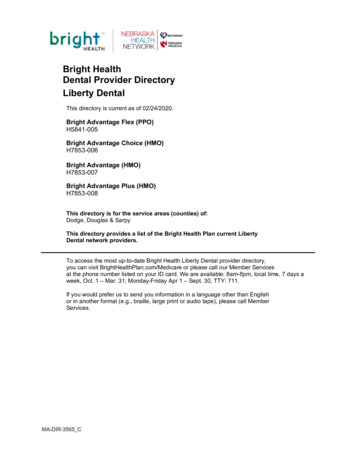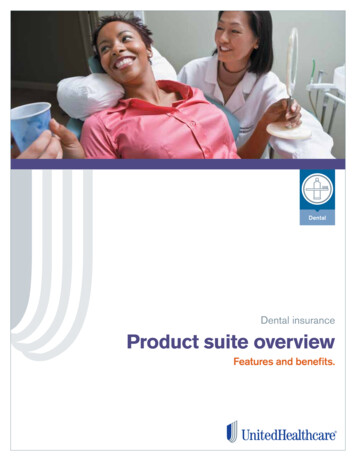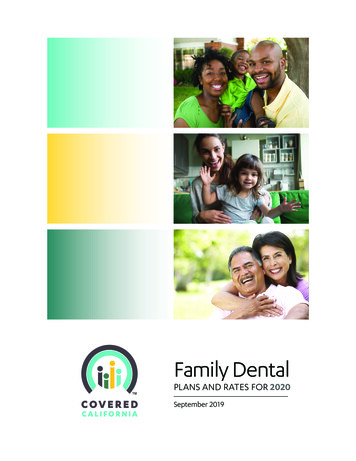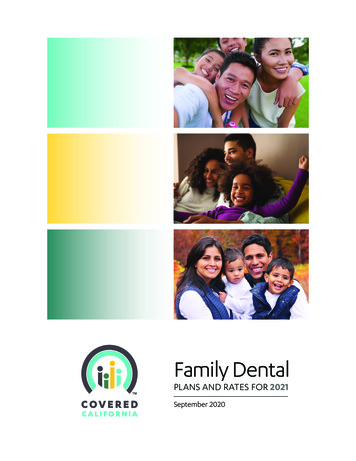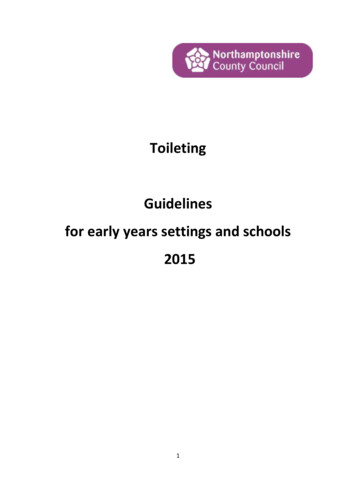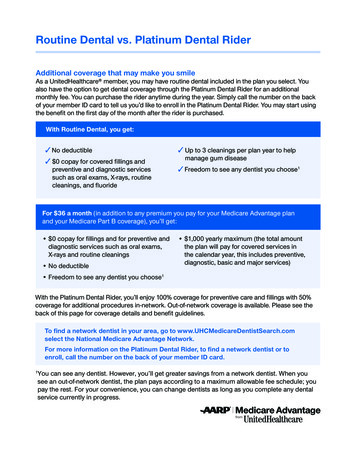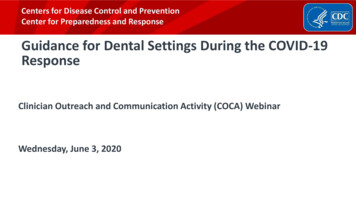
Transcription
Centers for Disease Control and PreventionCenter for Preparedness and ResponseGuidance for Dental Settings During the COVID-19ResponseClinician Outreach and Communication Activity (COCA) WebinarWednesday, June 3, 2020
Continuing EducationContinuing Education is not offered for this COCA Call.
To Ask a Question Using the Webinar System– Click the Q&A button.– Type your question in the Q&A box.– Submit your question. If we are unable to get to your question during the call, you may alsoemail your question to coca@cdc.gov. For media questions, please contact CDC Media Relations at 404-6393286, or send an email to media@cdc.gov.
For More Clinical Care Information on COVID-19 Call COVID-19 Clinical Call Center at 770-488-7100 (24 hours/day). Refer patients to state and local health departments for COVID-19testing and test results.– Clinicians should NOT refer patients to CDC to find out where orhow to get tested for COVID-19, OR to get test results. Visit CDC’s Coronavirus (COVID-19) website:https://www.cdc.gov/coronavirus Visit emergency.cdc.gov/coca over the next several days to learn aboutfuture COCA Calls.
Today’s Presenters Casey Hannan, MPH (no slides)Director, Division of Oral HealthNational Center for Chronic Disease Prevention andHealth PromotionCenters for Disease Control and Prevention CDR Marie de Perio, MD (USPHS)Worker Safety TeamCOVID-19 ResponseCenters for Disease Control and Prevention Michele Neuburger, DDS, MPHInfection Prevention Control TeamCOVID-19 ResponseCenters for Disease Control and Prevention LCDR Megan Casey, RN, BSN, MPH, CIC (USPHS)Worker Safety TeamCOVID-19 ResponseCenters for Disease Control and Prevention Alberto Garcia, MSWorker Safety TeamCOVID-19 ResponseCenters for Disease Control and Prevention
Guidance for Dental SettingsMichele Neuburger, DDS, MPHDental OfficerCDC COCA Call Guidance for Dental Settings Duringthe COVID-19 ResponseJune 3, 2020cdc.gov/coronavirus
CDC Guidance for Dental Settings Updated on May 19, 2020 Key Points– Dental settings have unique characteristics that warrant specific infectioncontrol considerations.– Dental healthcare personnel (DHCP) should: Prioritize the most critical dental services and provide care in a way thatminimizes harm to patients from delaying care and harm to patients andpersonnel from potential exposure to COVID-19. Proactively communicate to both DHCP and patients the need to stay athome if sick. Know the steps to take if a patient with COVID-19 symptoms enters ncov/hcp/dental-settings.html
Summary of Recent Changes Recommendations are provided for resuming non-emergency dental care duringthe COVID-19 pandemic. Expanded recommendations for provision of dental care to both patients withCOVID-19 and patients without COVID-19. New information regarding:– Facility and equipment considerations– Sterilization and disinfection– Considerations for the use of test-based strategies to inform patient care
Key Recommendations for DentalHealthcare Personnel Apply the guidance found in the Framework for Healthcare SystemsProviding Non-COVID-19 Clinical Care During the COVID-19 Pandemic todetermine how and when to resume non-emergency dental care. Stay informed and regularly consult with state or local health departmentsfor region-specific information and recommendations. Continue to practice universal source control and actively screen for feverand symptoms of COVID-19 for all people (patients, visitors and staff) whoenter the dental facility. Ensure that DHCP have the appropriate amount and type of personalprotective equipment (PPE) and supplies to support the patient volume.
Recommendations for Communities ExperiencingNo to Minimal Community Transmission Defined as evidence of isolated cases or limited community transmission,case investigations underway; no evidence of exposure in large communalsetting. Provide dental care to patients without suspected or confirmed COVID-19using strict adherence to Standard Precautions.– Given that patients may be able to spread the virus while presymptomatic or asymptomatic, DHCP should use additionalheightened precautions listed in the guidance whenever feasible. Stay updated about local transmission trends by reviewing information anddata from state and local health departments.
Recommendations for Communities ExperiencingMinimal to Moderate or Substantial CommunityTransmission Minimal to moderate community transmission is defined as sustainedtransmission with high likelihood or confirmed exposure within communalsettings and potential for rapid increase in cases. Substantial community transmission is defined as large scale communitytransmission, including communal settings (e.g., schools, workplaces). Provide dental care using additional considerations listed in CDC guidanceto protect both DHCP and patients and prevent the spread of COVID-19 indental facilities.
Considerations for Use of Test-Based Strategies toInform Patient Care Consider using a tiered approach to universal PPE based on the level oftransmission in the community. Consider implementing pre-admission or pre-procedure testing forCOVID-19, which might inform implementation of PPE use, especially in thesituation of PPE shortages.– Depends on testing availability and how rapidly results are available.– Limitations should be considered, including: Negative results from patients during their incubation period whocould become infectious later. Potential false negative tests.
Patient Management Contact all patients prior to dental treatment.– Screen for symptoms consistent with COVID-19.– Triage to assess need for in-office dental care. Systematically assess all patients and visitors upon arrival.– Ask about the presence of fever or other symptoms consistent withCOVID-19.– Actively check the patient’s temperature. Ask patient to re-don their face covering at the completion of care. Request that the patient inform the dental clinic if they develop symptoms or arediagnosed with COVID-19 within 14 days after the dental appointment.
Facility and Equipment Considerations Take steps to ensure that all patients, visitors, and staff adhere torespiratory hygiene and cough etiquette. Place chairs in the waiting room at least six feet apart. Remove toys, magazines, and other frequently touched objects thatcannot be regularly cleaned or disinfected. Minimize the number of persons waiting in the waiting room. Review the manufacturer’s instructions for re-initiating use of allequipment and devices after a period of non-use.
Administrative Controls and Work Practices Whenever possible, DHCP should remain with one patient until dental care iscomplete and minimize the practice of one DHCP providing care to multiplepatients at once. Set up operatories so that only the supplies and instruments needed for the dentalprocedure are readily accessible. Avoid aerosol-generating procedures (such as the use of dental handpieces,air/water syringe and ultrasonic scalers) whenever possible. If necessary for dentalcare:– Use four-handed dentistry, high evacuation suction, and dental dams tominimize droplet spatter and aerosols.– Limit number of personnel during the procedure to only those essential forpatient care and procedure support.
Monitor and Manage Dental Healthcare Personnel Implement sick leave policies for DHCP that are flexible, non-punitive, andconsistent with public health guidance.– DHCP should not come to work if they suspect they have COVID-19. Ask DHCP to regularly monitor themselves for fever and symptomsconsistent with COVID-19. Screen all DHCP at the beginning of their shift for fever and symptomsconsistent with COVID-19. Follow CDC’s Healthcare Personnel with Potential Exposure Guidance ifDHCP experience a potential work exposure to COVID-19.
Hand Hygiene Practice strict adherence to hand hygiene, including:– Before and after all patient contact, contact with potentiallyinfectious material, and before putting on and after removing PPE,including gloves.– Use alcohol-based hand rub (ABHR) with 60-95% alcohol or washhands with soap and water for at least 20 seconds. If hands are visiblysoiled, use soap and water before returning to ABHR.– Ensure that hand hygiene supplies are readily available.
Universal Source Control DHCP should:– Wear a facemask or cloth face covering at all times while they are in thedental setting.– Take steps to prevent self-contamination.– Perform hand hygiene immediately before and after any contact with thefacemask or cloth face covering. Dental settings should:– Provide DHCP with training about when, how, and where facemasks and clothface coverings can be used.– Request that patients and visitors wear a cloth face covering, or provide afacemask if supplies are adequate.
Treating Patients with Suspected or ConfirmedCOVID-19 If a patient arrives at your facility and is suspected or confirmed to have COVID-19,defer dental treatment and take the following actions:– Give the patient a mask to cover his or her nose and mouth.– If the patient is not acutely sick, send the patient home, and instruct the patient to calltheir primary care provider.– If the patient is acutely sick (for example, has trouble breathing), refer the patient to amedical facility, or call 911. If emergency dental care is medically necessary, follow CDC’s Interim Infection Prevention andControl Recommendations for Patients with Suspected or Confirmed Coronavirus Disease 2019(COVID-19) in Healthcare Settings, including the use of PPE. If aerosol-generating procedures must be performed, take precautions such as wearing an N95or higher-level respirator and ideally performing the procedure in an airborne infectionisolation room.
Environmental Infection Control Ensure that environmental cleaning and disinfection procedures are followedconsistently and correctly after each patient.– Refer to List N on the EPA website for EPA-registered disinfectants that havequalified under EPA’s emerging viral pathogens program for use against SARSCoV-2. To clean and disinfect the dental operatory after a patient without suspected orconfirmed COVID-19, wait 15 minutes after completion of clinical care and exit ofeach patient to begin to clean and disinfect room surfaces. To clean and disinfect the dental operatory after a patient with COVID-19, DHCPshould delay entry into the operatory until a sufficient time has elapsed for enoughair changes to remove potentially infectious particles.
Sterilization and Disinfection of Patient-Care Items Sterilization protocols do not vary for respiratory pathogens. Perform routine cleaning, disinfection, and sterilization protocols, andfollow the recommendations for Sterilization and Disinfection of PatientCare Items present in the Guidelines for Infection Control in Dental HealthCare Settings – 2003. Follow the manufacturer’s instructions for times and temperaturesrecommended for sterilization of specific dental devices.
Education and Training Provide DHCP with job- or task-specificeducation and training on preventingtransmission of infectious agents, includingrefresher training.– Training: Basic Expectations for SafeCare Ensure that DHCP are educated, trained, andhave practiced the appropriate use of PPEprior to caring for a patient.– Using PPE Training– Healthcare Respiratory ProtectionResources Training
For more information, contact CDC1-800-CDC-INFO (232-4636)TTY: 1-888-232-6348 www.cdc.govThe findings and conclusions in this report are those of the authors and do not necessarily represent theofficial position of the Centers for Disease Control and Prevention.
Engineering Controls for Dental SettingsAlberto Garcia, MSMechanical Engineercdc.gov/coronavirus
Maintaining Ventilation Systems Clean-to-(less-clean) airflow (e.g. reception desk - waiting area, workdesks - patient chairs) Increase filtration efficiency to the highest level compatible with the HVAC Investigate increasing outdoor air percentage in HVAC supply air Limit the use of demand-controlled ventilation Consider using portable HEPA air filtration unit Consider the use of upper-room ultraviolet germicidal irradiation (UVGI)
Patient Placement Strategies Individual patient rooms preferred If floor plan is open:– Ensure there is at least 6 feet of spacebetween patient chairs– Place physical barriers between patient chairs– Orient operatories parallel to the direction ofairflow if possible Patient orientation:– Patients should be oriented with their headaway from pedestrian corridors, towards therear wall when using vestibule-type officelayouts, and near the return air ventsGraphic by CDC/NIOSH
Patient Volume Strategies Identify maximumnumber of patients atany one time Allow a 15 minute waitperiod after patientleaves and beforebeginning the roomcleaning and disinfectionprocessGraphic by CDC/NIOSH
Personal Protective Equipment (PPE)and Strategies to Optimize SupplyCDR Marie A. de Perio, MD, FIDSAMedical Officercdc.gov/coronavirus
CDC’s PPE Recommendations for Dental Settings For procedures likely to generate splashes: gloves eye protection gown(or protective clothing) surgical mask For aerosol generating procedures: gloves eye protection gown N95or higher level respirator (instead of surgical mask) For patients with suspected or confirmed COVID-19: gloves eyeprotection gown N95 or higher level respirator
PPE Recommendations for Dental Settings Respirators should be used in thecontext of a respiratory protectionprogram, which includes medicalevaluations, training, and fit testing Dental healthcare personnel (HCP)should receive training on how to puton, use, and take off PPE Dental facilities should ensure that anyreusable PPE is properly cleaned,decontaminated, and maintained afterand between uses
Strategies for Optimizing PPE Supplies CDC recommends series of strategies to optimize supplies of PPE inhealthcare settings when there is limited supply Intended for leaders who are responsible for developing and implementingpolicies and procedures for preventing pathogen transmission in healthcaresettings
Surge Capacity Strata Ability to manage sudden, unexpected increase inpatient volume that would otherwise severelychallenge or exceed present capacity of facility Conventional capacity: measures consist of providingpatient care without any change in daily standardpractices Contingency capacity: measures may change dailystandard practices but may not have significant impacton the care delivered to patient or safety of HCP Crisis capacity: not commensurate with U.S. standardsof care1HickJL, Barbera JA, Kelen GD. Refining surge capacity: conventional, contingency, andcrisis capacity. Disaster Med Public Health Prep. 2009;3(2 Suppl): S59-67.
Conventional CapacityEngineering Controls Perform aerosol generating procedures on COVID-19 patients in airborne infectionisolation rooms (AIIR) Use physical barriersAdministrative Controls Use telemedicineExclude all HCP not directly involved in patient careLimit face-to-face HCP encounters with patientImplement source controlImplement cohorting of patients and HCP
Conventional CapacityPersonal Protective Equipment (PPE) Use alternatives to N95 respirators– N99, N100, P95, P99, P100, R95, R99, or R100– Powered air purifying respirators (PAPRs)– Elastomeric respirators
When to Move to Contingency and Crisis Capacity Understanding of current inventory and supply chainUnderstanding of utilization rateImplementation of conventional capacity strategiesCommunication with healthcare coalitions, state/local partnersDiscussions with local and state public health and emergency managementpartners
Contingency Capacity (Expected Shortages)Administrative Controls Temporarily suspend annual fit testingPPE Use N95 respirators beyond the manufacturer-designated shelf life fortraining and fit testing Extend the use of N95 respirators
Crisis Capacity (Known Shortages)PPE Use respirators beyond the manufacturer-designated shelf life forhealthcare delivery Use respirators evaluated and complying with standards used in othercountries Implement limited re-use of N95 respirators Prioritize the use of N95 respirators and facemasks by activity
Additional CDC Resources Using Personal Protective Equipment (PPE)Personal Protective Equipment: Questions and AnswersStrategies to Optimize the Supply of PPE and EquipmentConsiderations for Release of Stockpiled N95s Beyond the ManufacturerDesignated Shelf Life Decontamination and Reuse of Filtering Facepiece Respirators
Factors to Consider when Planning to PurchaseRespirators from Another CountryIncluding KN95 Respirators from ChinaLCDR Megan Casey, RN, BSN, MPH, CICNurse Epidemiologistcdc.gov/coronavirus
Users can be confident that NIOSH-approved respiratorswill provide the expected level of protection. NIOSH-approved respirators areencouraged regardless of their countryof origin Since 2008, NIOSH has required theApproval number to be on the respiratoror strap Beware of false claims– Inspect the respirator– Inspect the packaging– Review the required labeling /imported-respirators/How to tell if a respirator is NIOSH-approved
CDC recommends Crisis Strategies when Conventionaland Contingency Strategies have been exhausted One crisis option is to use respirators inthe workplace conforming to standardsfrom seven other countries, includingChina Confidence in NIOSH approval holders– check the CEL for list of approvalholders Be cautious if seller is not a NIOSHapproval holderCEL: NIOSH Certified Equipment List: https://wwwn.cdc.gov/niosh-cel/
Evaluate the Manufacturer Investigate the company you intend to purchase from– Ask colleagues about any experience they may have had with themanufacturer of interest– Utilize every available option to obtain more information about amanufacturer– Consider if you would contemplate this purchase with thismanufacturer in circumstances other than those existing during theCOVID-19 pandemic
Evaluate the Manufacturer (continued) Check to determine if manufacturer is aNIOSH approval holderDetermine if the manufacturer has atest report from a laboratory that isISO/IEC 17025 accredited CNAS Accredited laboratories The European Union CommissionwebsiteDocumentation is crucial BUT not a reliable indicator of theproduct’s performance. Documentation easy to falsify
Evaluate Devices Check the FDA Emergency Use Authorization list Evaluate samples of the product prior to making apurchase Purchase respirators with traditional head strapdesigns– Difficult to fit respirators with ear loops Check filtration efficiency results on NIOSH website– g/default.html
Since the beginning of April 2020, NIOSH NPPTL hasevaluated over 194 products Approximately 42% of the productsevaluated achieved filtration efficiencygreater than 95% (PASSED LIMITEDTEST) 58% achieved filtration efficiency below95%. (FAILED LIMITED TEST) Make sure product is listed on FDA EUA
Evaluate the Device Evaluate samples of the product prior to making a purchase– Obtain samples from the manufacturer– Evaluate the respirator yourself by conducting a fit test with multiplepeople in your organization per the requirements of your respiratorprotection program
Evaluate the Contract Terms Beware of price gouging– KN95 selling for 2 - 3 per unit– If paying more than 2 - 3 per unit, you are likely overpaying– Any per unit price below 2 - 3 is suspect– This will change through time, as the circumstances change Do not be pressured into prepaying for your purchase Establish provisions in the contract to protect your purchase through anythird-party
NIOSH will continueto prioritize testingaccording to thescheme shown
Additional ResourcesFDA Emergency Use Authorization* March 28 FDA EUA on imported non-NIOSH approved FFRs– Exhibit 1 to FDA's March 28 EUA - list of authorized respirators May 7 FDA EUA on Non-NIOSH-Approved Disposable Filtering Facepiece Respirators Manufactured in China– Appendix A- Authorized Imported, Non-NIOSH Approved Respirators Manufactured in China– Respirator Models Removed from Appendix A- Respirator Models No Longer AuthorizedAdditional Related Information for Purchasers of Respiratory Protection Equipment The NIOSH counterfeit respirator page CDC Crisis Capacity Strategies for Optimizing N95s Understanding the Use of Imported Non-NIOSH-Approved Respirators Considerations when Purchasing Respirators from Another Country – Includes a link to a webinar onpurchasing international respirators
For more information, contact CDC1-800-CDC-INFO (232-4636)TTY: 1-888-232-6348 www.cdc.govThe findings and conclusions in this report are those of the authors and do not necessarily represent theofficial position of the Centers for Disease Control and Prevention.
To Ask a Question Using the Webinar System– Click on the Q&A button in the Zoom webinar system.– Type your question in the Q&A box.– Submit your question.– You may also email your question to coca@cdc.gov.For media questions, please contact CDC Media Relations at 404-639-3286 or email media@cdc.gov.For more Clinical Care information on COVID-19– Call COVID-19 Clinical Call Center at 770-488-7100 (24 hours/day).– Refer patients to state and local health departments for COVID-19 testing and test results. Clinicians should NOT refer patients to CDC to find out where or how to get tested forCOVID-19 OR to get test results.– Visit CDC’s Coronavirus (COVID-19) website: https://www.cdc.gov/coronavirus.
Today’s COCA Call Will Be Available On-DemandWhen: A few hours after the live callWhat: Video recordingWhere: On the COCA Call webpage fo 060320.asp
Upcoming COCA CallTopic: Updated Information for Long-term Care Facilities during COVID-19PandemicDate: Tuesday, June 16, 2020Time: 2:00-3:00 PM ET
COCA Products & ServicesCOCA Call Announcements contain all informationsubscribers need to participate in COCA Calls. COCACalls are held as needed.Monthly newsletter that provides information on CDCtraining opportunities, conference and trainingresources, the COCA Partner Spotlight, and theClinician Corner.As-needed messages that provide specific, immediateaction clinicians should take. Contains comprehensiveCDC guidance so clinicians can easily followrecommended actions.
COCA Products & ServicesMonthly newsletter providing updates on emergencypreparedness and response topics, emerging publichealth threat literature, resources for healthprofessionals, and additional information importantduring public health emergencies and disasters.Informs clinicians of new CDC resources and guidancerelated to emergency preparedness and response.This email is sent as soon as possible after CDCpublishes new content.CDC's primary method of sharing information abouturgent public health incidents with public informationofficers; federal, state, territorial, and local publichealth practitioners; clinicians; and public healthlaboratories.
Join COCA’s Mailing List Receive information about:– Upcoming COCA Calls– Health Alert Network (HAN) messages– CDC emergency response activations– Emerging public health threats– Emergency preparedness andresponse conferences and trainingopportunitiesemergency.cdc.gov/coca
Join Us on Facebook
Thank you for joining us today!emergency.cdc.gov/coca
Jun 03, 2020 · Substantial community transmission is defined as large scale community transmission, including communal settings (e.g., schools, workplaces). Provide dental care using additional considerations listed in CDC guidance to protect both DHCP and patients and prevent the



